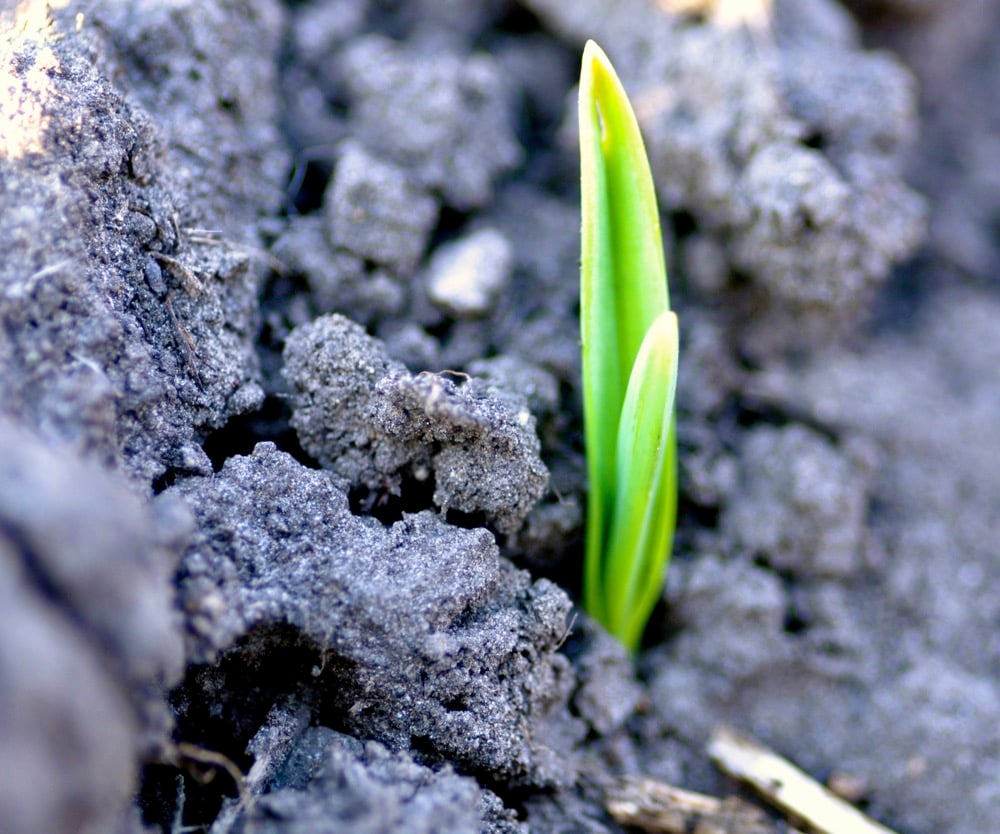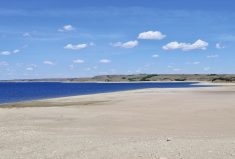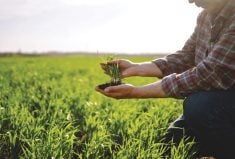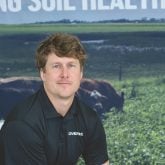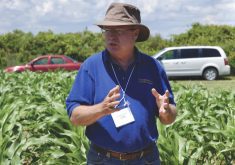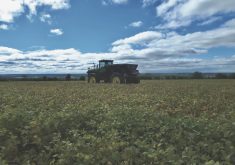
Jocelyn Velestuk did a lot of spitting the first time she met her future father-in-law. It made a lasting impression.
As she describes it, Velestuk and her then fiancé and his father were touring around the farm she would soon marry into. Being a soil scientist, Velestuk scooped up handfuls of topsoil here and there, checking its properties and thinking through its yield potential. “I always like to get a feel for the soil,” she says, but the soil that day was too dry to make a good assessment. “We didn’t have any water so I spit in my hand and started texturing the soil.”
The action came naturally and it tells a lot about Velestuk’s character and priorities. “But they thought that was kind of odd I guess,” she says.
Read Also

Agronomists share tips for evaluating new crop products and tech: Pt. 3
With new products, new production practices and new technology converging on the agriculture industry at a frenetic pace in recent…
The Velestuks’ annual crop and cattle farm is in the thin black soils north of Broadview, Sask. “We definitely have a lot challenges here with low organic matter,” she says, which is why much of the farm is dedicated to pasture, perennial forage and cattle.
Cover crops, manure applications and overall efforts to improve soil health are key management goals for the farm. Velestuk also promotes these methods across the province. In addition to farming, she is an agronomist with Western Ag and a board member with the Saskatchewan Soil Conservation Association.
“I hope to be a leader in soil health and agriculture sustainability and reach as many farmers as I can to make sure we can sustain agriculture long term,” she says.
Canada’s soils have always depended on the individual effort and care of farmers, but leadership like Velestuk’s has helped bridge over a deep dip in government investment.
Soil gets back on the map
Scott Smith is one of the last soil surveyors with Agriculture and Agri-Food Canada (AAFC), and he’s retiring. Disinterest from a federal perspective and ongoing retirements have gutted the program. “Ten years ago, AAFC had 50 people doing this work,” says Smith, who works at the research centre in Summerland, B.C. “We’re in a hiatus with provision of new soil information to Canadians.”
The good news, Smith says, is that interest is picking up. “People are asking more than ever for high-resolution soils information,” he says.
The Food and Agriculture Organization of the United Nations (FAO) has helped put soils back on the agenda, Smith says, with two factors fertilizing the revival: Using soils to sequester carbon thereby helping to mitigate climate change, and taking care of the health of soils to feed the growing world population.
It sparked a soil-health trend in Canada. “The federal department seems to be in a hiring mode, driven by a commitment to reinvest in government research,” Smith says.
And at the University of Saskatchewan, associate professor of soil science Angela Bedard-Haughn — whom Smith calls a “bright light” — leads a new soil-mapping project. The project, with funding from the Saskatchewan Ministry of Agriculture, Saskatchewan Canola Development Commission and Saskatchewan Pulse Crop Development Board, is to develop an online and interactive soil map.
“Farmers will be able to use an app to look under the hood of their fields,” Bedard-Haughn says.
The application will be in beta testing soon and the first version could launch this winter. At its core is information from the existing soil surveys, which were done a half-century ago. But for subsequent versions, Bedard-Haughn and her team will add features to show details within fields — including distinct soil types and areas with the most erosion or higher nutrients. They’re also using drones to collect high-resolution elevation images.
“It’s like building a quilt,” Bedard-Haughn says. “Each year we could add something to make it better.”
For her, it will be so much more than a tool to help growers with variable-rate applications.
“We have many different ways to talk about precision agriculture,” she says. “This will help farmers determine the best use for all acres in a field. They may discover that some acres are just not well suited to annual cropping. Or in one field they may be able to seed two distinct varieties adapted to different conditions — one variety with high yield potential could go in the high-performing parts of the field and another more tolerant of diversity could go on hilltops, for example.”
World focus on soil
Bedard-Haughn is on a sabbatical at the International Soil Resource Information Centre (ISRIC) in the Netherlands to learn from one of the world’s leading soil organizations.
Tomislav Hengl, a researcher at ISRIC, leads the SoilGrids project which, according to a PLOS Journal article, provides global predictions for standard numeric soil properties — organic carbon, bulk density, cation-exchange capacity, pH, soil texture fractions and coarse fragments — at depths from zero to 200 cm.
SoilGrids recently improved to provide soil data based on grids of 250 metres square, up from one-kilometre resolution in the previous version.
“We are still far away from helping actual farmers,” Hengl says. “Once we get toward 100-metre and 10-metre resolutions, farmers will be making direct use of SoilGrids.”
Part of the ISRIC mandate is to collaborate with partners around the world to build and refine their own applications. That is why Bedard-Haughn is there.
While Saskatchewan and other provinces — Alberta, Ontario and B.C. — have digital mapping programs, Canada is playing catch-up to the Netherlands, France and Australia. Bedard-Haughn and Smith are part of the Canadian Digital Soil Mapping Working Group tying these efforts together with the goal to advance Canada’s digital soil map.
The new approach, as Smith envisions, will do away with the old descriptions — Newdale clay loam, Oxbow clay, Ellerslie clay loam, for example — and just list the soil properties: carbon content (an indicator of organic matter), sand-silt-clay percentages and more. Application of SoilGrids knowledge could lead to a tested and proven program to predict these properties for small grids across a farm. Bigger and bigger farms will then be able to use these details to make quick and possibly automated decisions to improve soil health — and therefore profitability and sustainability — on smaller and smaller pieces of land.
“This is a whole new ballgame,” Smith says.
Jocelyn Velestuk is one champion on the farm cheering these new soil management initiatives. “I really hope the soil health trend takes off because it will be a really good thing for the future of agriculture.”
Jay Whetter is a communications manager with the Canola Council of Canada.

